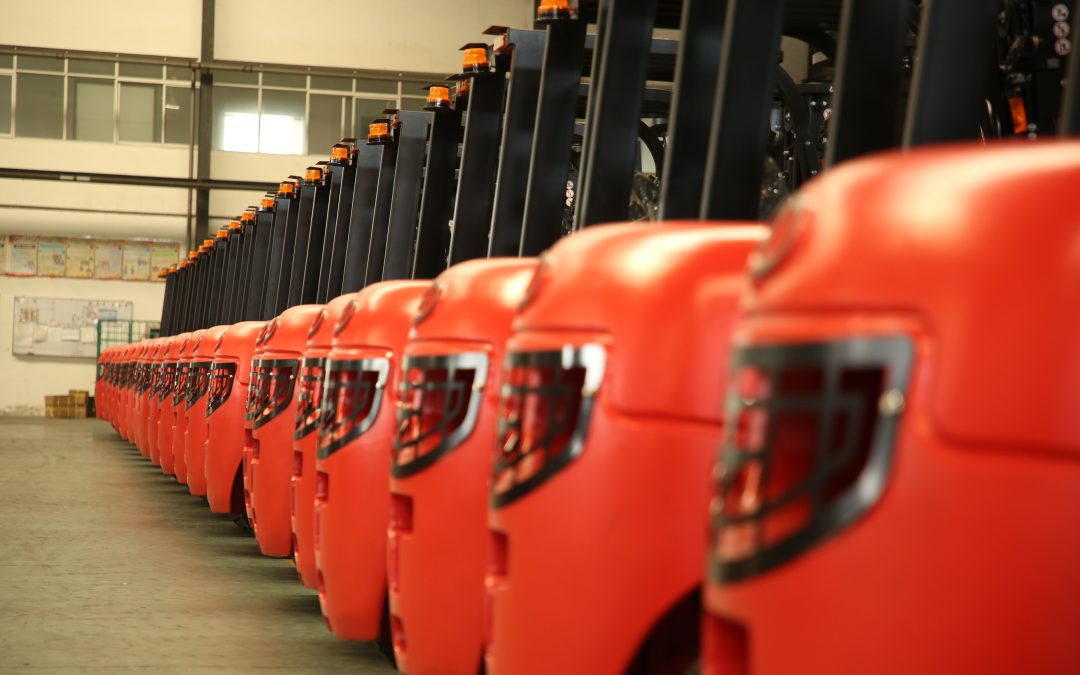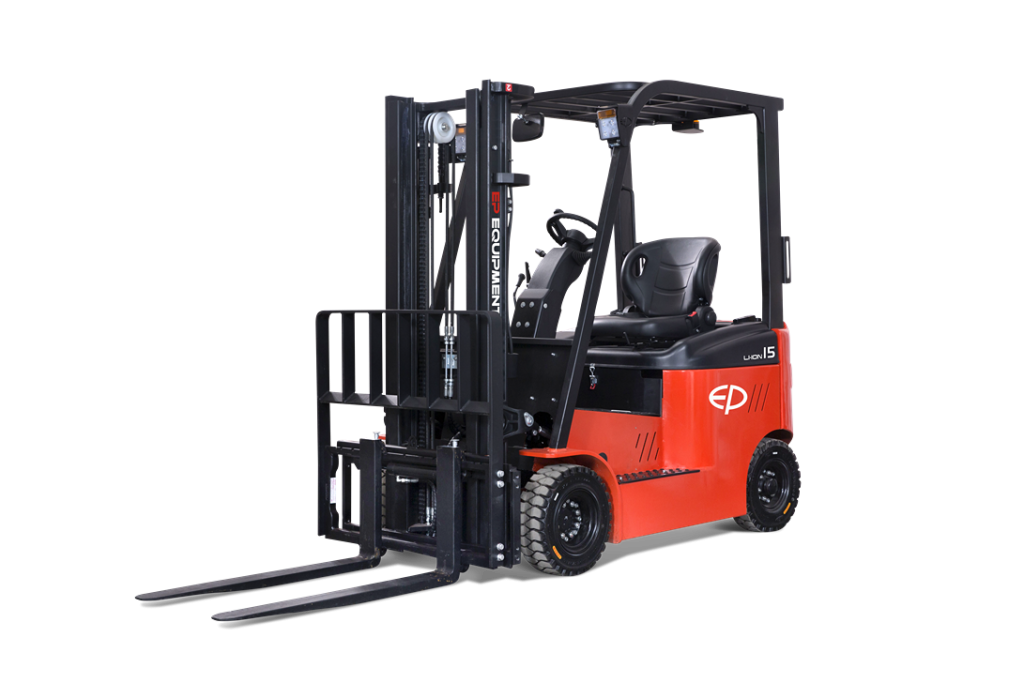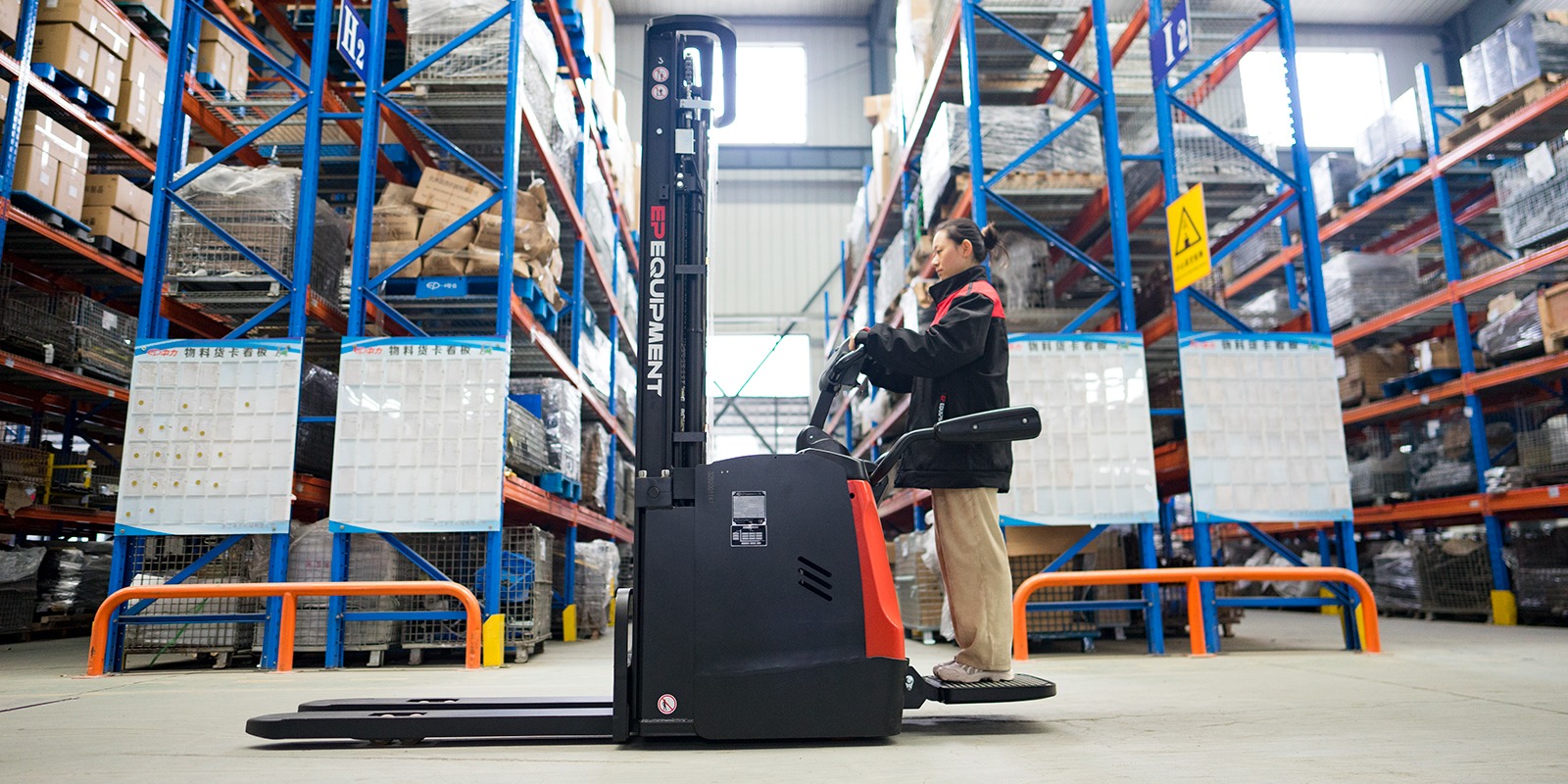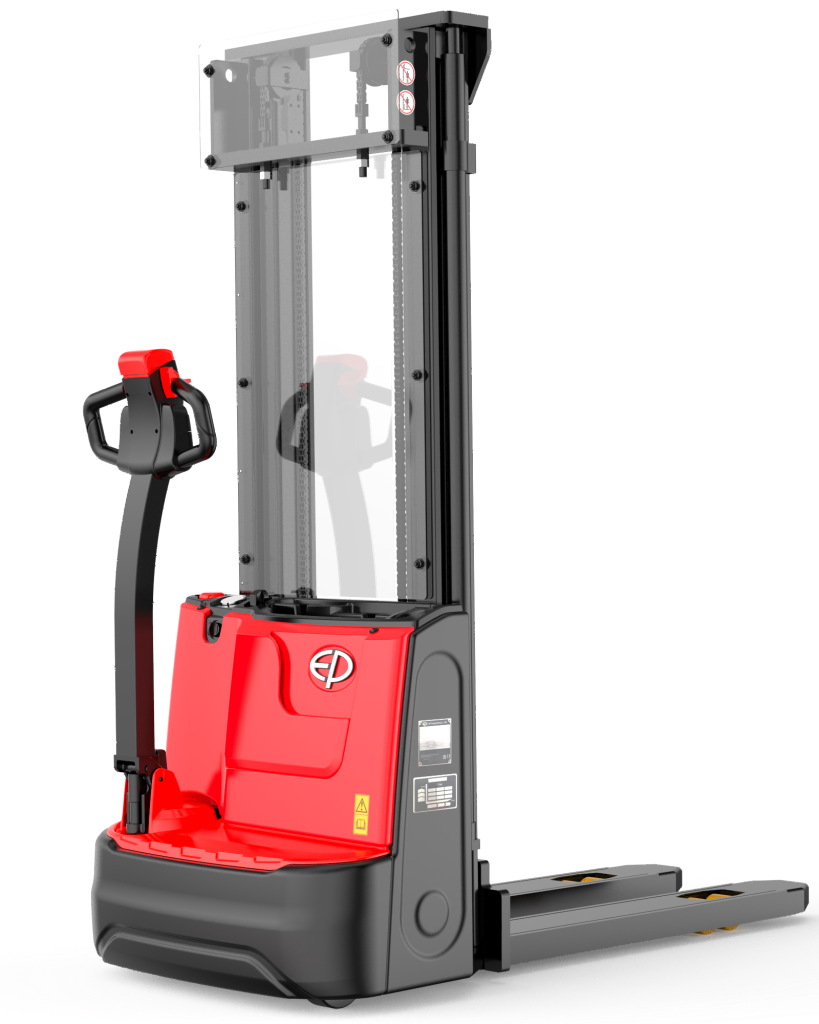Forklift terms can be hard to comprehend, especially if you’re new to the industry. To assist you in navigating the forklift world, we’ve compiled a comprehensive glossary of common forklift terms. This resource aims to clarify, educate, and support your understanding, whether you’re just starting out or are looking to refresh your knowledge.
This glossary has 3 main categories, including forklifts types, parts, and features.
Forklift Types
Reach forklift
This forklift is specialized for storage environments with very narrow aisles. It features a unique telescopic mast and an extendable fork that can ‘reach’ into shelving units to access loads. This design allows for efficient use of storage space by minimizing the aisle width required for operation.
At EP, we offer a range of warehouse equipment including small electric forklifts, which are perfectly suitable for maneuvering and operating in narrow aisles.
Counterbalance Forklift
The most widely-used type of forklift. It has a straightforward design with the forks protruding from the front of the machine, and a counterweight at the back to stabilize loads. This forklift is versatile and can be used in a variety of settings, from warehouses to construction sites, for transporting and lifting a range of goods.
EP has a wide portfolio of electric counterbalance trucks, for example, our CPD series are electric counterbalance forklift trucks with up to 2000KG of capacity. With Li-Ion technology build into the L1 counterbalance truck, the machine even allows quick charging.
Rough Terrain Forklift
Built for outdoor use on uneven and rough surfaces, this forklift is equipped with large, durable tires and a robust design. It’s commonly used in construction, agriculture, and any industry requiring the movement of materials over challenging terrain.

Electric forklift by EP, with robust design, durable tires and high capacity, suitable for heavy industry and rough terrain.
At EP, we proudly present the EFL series – they keep pace with every application need, especially challenges posed by rugged environments or tight work shifts.
Order Picker Forklift
Specifically designed for warehouse order picking tasks. This forklift allows the operator to be lifted up with the forks to access high shelves directly. It is ideal for hand-picking and transporting smaller orders and is commonly used in distribution centers and large-scale retail warehouses.
EP offers various models of order pickers for diversified requirements, with different batteries and picking height of up to 6.5 meters.
Walkie Stacker Forklift
A type of pedestrian forklift where the operator walks behind the vehicle. It’s ideal for stacking operations in tight spaces and for short-distance transportation of pallets.
EP offers a range of diversified models that can be used as both standard walkie stackers (when the platform is raised and operated with low speed) and ride-on, drive-through stackers (when the platform is used by the operated and the speed is increased), to suit your needs for different tasks.
Telescopic Handler Forklift
Telescopic handler, as called telehandler, is a highly versatile forklift, featuring a boom and extendable arm that can reach high elevations. It’s often used in construction and agriculture for tasks that require lifting materials to significant heights or distances.
Side Loader Forklift
Uniquely designed for handling long or wide loads, such as timber or pipes, in narrow aisles where turning is difficult. This forklift carries loads on its side, allowing it to move easily through narrow passageways without turning the load.
Pallet Stacker
A stacker is a vehicle that is used to lift, move and stack pallets. Designed for stacking and transporting pallets in confined spaces, stackers are an alternative to traditional pallet trucks as they can lift as well as move, and they are a better choice than forklifts as they are less cumbersome and easier to manoeuvre.
EP Equipment offers a large variety of electric pallet stackers for every application. Starting with entry level stacker for light duty application over heavy duty stacker with lead acid or Li-Ion Battery to special application trucks like counterbalance stacker trucks or end rider solutions. Read our complete stacker guide to understand more about stackers – how do they work, their use cases, benefits, and what is the right one for you.
Parts & Attachments
Pneumatic Tires
These tires are air-filled and designed for outdoor forklift use. They provide excellent traction and shock absorption on rough, uneven terrain. Their air-filled nature helps cushion the ride, reducing the impact on the forklift and load, which is crucial for operations on construction sites or over irregular surfaces.
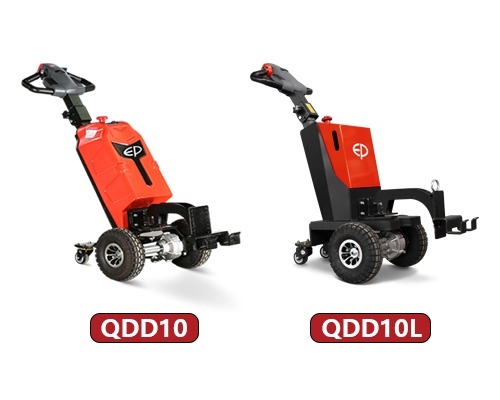
EP’s QDD10 and QDD10L tow tractors with 250mm diameter pneumatic tyres,
Cushion Tires
Made from solid rubber, these tires are compact and suitable for indoor or smooth concrete surfaces. Their small turning radius makes them perfect for tight spaces, commonly used in warehouse environments where space efficiency is key.
Forklift Side Shift
A versatile attachment that enables the forklift operator to move the forks and the load laterally, enhancing precision without needing to reposition the entire vehicle. This is especially useful in tight warehouse spaces for aligning pallets or loads with more accuracy.
Forklift Rotator
Fork rotators allows for 360-degree rotation of the forks, enabling tasks such as dumping bins or rotating loads. It’s particularly useful in industries like recycling or agriculture, where materials need to be poured or positioned differently.
Fork Positioner
Fork positioners are designed to automatically adjust the distance between the forks, this attachment adds flexibility and efficiency, especially when handling loads of varying sizes. It saves time by allowing the operator to adapt fork spacing without manual adjustment.
Forklift Load Backrest
A frame attached to the carriage to prevent the load from shifting backward toward the operator, enhancing safety during lifting operations.
Forklift Overhead Guard
A protective metal roof-like structure over the operator’s head. It provides safety by protecting the operator from falling objects.
Forklift Fork Extensions
Attachments that slide over the existing forks to extend their length for handling larger and more stable loads.
Forklift Mast
The upright assembly on the forklift’s front, responsible for lifting, lowering, and positioning the load. Available in different configurations, the mast’s design determines the maximum height to which a load can be lifted and how far forward it can reach.
Forks
Also known as tynes, these are the horizontal blades on which the load is placed. They are available in various lengths to accommodate different types of loads and pallet sizes.
Tynes
Another term for the forks or the arms of the forklift that support and lift the load.
Counterweight
Located at the rear of the forklift, this weight helps balance the loads lifted by the forks. It is essential for maintaining the forklift’s stability and preventing it from tipping over when carrying heavy loads.
Tilt Cylinders
Hydraulic cylinders that enable the mast to tilt forwards and backwards. This feature helps the operator to correctly angle and securely manage the load during lifting and lowering operations.
Lift Cylinder
A key component of the forklift’s lifting mechanism, this hydraulic cylinder raises and lowers the mast, allowing for the vertical movement of the forks and the load.
Forklift Carriage
The framework to which the mast, forks, and other attachments are mounted. It moves vertically along the mast and is a crucial part of the forklift’s lifting mechanism.
Hydraulic Fluid Reservoir
This tank holds the hydraulic fluid that powers the forklift’s lift and tilt functions. It is a crucial component for the hydraulic system’s operation.
Hydraulic Lift Cylinder
This cylinder powers the lifting mechanism. Using hydraulic fluid, it creates the force needed to raise and lower the mast and, consequently, the load.
Tiller Head
Found on walk-behind forklifts, this is the steering handle containing controls for the forklift’s movement and the operation of the forks. It allows for precise maneuvering in tight spaces.
Forklift Features
Free Lift (FL)
This refers to the height a forklift’s forks can be raised before the mast itself starts to extend. Free lift is particularly important in low-clearance environments, allowing for the lifting of the load without increasing the overall height of the mast.
Hook Fork
A type of forklift fork that attaches to the carriage using hooks. These forks are easily adjustable and replaceable, making them versatile for different types of loads and operations.
Maximum Full Lift Height (MFH)
This is the highest point to which the forks of a forklift can be raised. It is a critical factor in determining the suitability of a forklift for various stacking and storage heights.
Overall Lowered Height (OAL)
This dimension indicates the total height of the forklift when the mast is fully collapsed. It is crucial for ensuring that the forklift can pass safely under overhead obstructions like doorways or beams.
Rated Load Capacity
The maximum weight a forklift can safely carry. This capacity can vary based on factors like the load center, lift height, and the forklift’s configuration.
Turning Radius
The minimum space required for a forklift to make a full turn. A smaller turning radius indicates better maneuverability, particularly important in tight warehouse spaces.
Fork Length
The measurement of the forks from the front to the back. The length of the forks should be suitable for the type of loads being handled, ensuring safe and balanced lifting.
Ground Clearance
The distance between the lowest point of the forklift (excluding the wheels) and the ground. Adequate ground clearance is essential for preventing the underside of the forklift from scraping on uneven surfaces.
Fork Spread
The distance between the outer edges of the forks. Adjustable fork spreads allow for the handling of loads of various sizes and contribute to the forklift’s versatility.
Load Center
This measurement indicates the distance from the face of the forks to the load’s center of gravity. The standard load center distance is critical in determining the forklift’s rated load capacity.
Mast Type (e.g., Duplex, Triplex)
The mast type refers to the mast’s construction and how many stages it has for extension. Duplex (two-stage) and Triplex (three-stage) are common types, with Triplex being suitable for higher lifting heights.
Craving for more? Let us know!
As you’ve journeyed through this comprehensive glossary, we hope you’ve gained some insights into the world of forklifts.
If you’re looking to enhance your operations with high-quality forklifts and material handling equipment, or if you have any questions about finding the perfect fit for your needs, don’t hesitate to reach out to us. Our expert team is always ready to assist you.
???? Explore our range of products and services, and let’s elevate your material handling experience together. Contact us today and take the first step towards optimizing your operations with EP Equipment!

